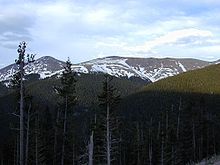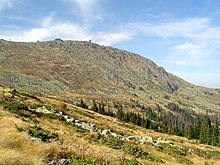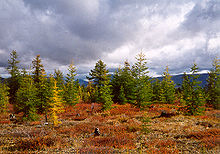Tree line
[5] Due to their vertical structure, trees are more susceptible to cold than more ground-hugging forms of plants.
[7][8] A series of warm summers in the 1940s seems to have permitted the establishment of "significant numbers" of spruce seedlings above the previous treeline in the hills near Fairbanks, Alaska.
Wind can mechanically damage tree tissues directly, including blasting with windborne particles, and may also contribute to the desiccation of foliage, especially of shoots that project above the snow cover.
However, snow accumulation in sheltered gullies in the Selkirk Mountains of southeastern British Columbia causes the tree line to be 400 metres (1,300 ft) lower than on exposed intervening shoulders.
[22] In some mountainous areas, higher elevations above the condensation line, or on equator-facing and leeward slopes, can result in low rainfall and increased exposure to solar radiation.
Many south-facing ridges of the mountains of the Western U.S. have a lower treeline than the northern faces because of increased sun exposure and aridity.
[23] Extremely low temperatures, especially when prolonged, can freeze the internal sap of trees, killing them.
In addition, permafrost in the soil can prevent trees from getting their roots deep enough for the necessary structural support.
The Arctic forest–tundra transition zone in northwestern Canada varies in width, perhaps averaging 145 kilometres (90 mi) and widening markedly from west to east,[24] in contrast with the telescoped alpine timberlines.
[29] For example, the northern halves of Hoste and Navarino Islands have Nothofagus antarctica forests but the southern parts consist of moorlands and tundra.
In addition, in some tropical or island localities, the lack of biogeographical access to species that have evolved in a subalpine environment can result in lower tree lines than one might expect by climate alone.
In addition, permafrost has a major impact on the ability of trees to place roots into the ground.
Maritime influences such as ocean currents also play a major role in determining how far from the equator trees can grow as well as the warm summers experienced in extreme continental climates.
Here are some typical polar treelines: Trees exist on Tierra del Fuego (55°S) at the southern end of South America, but generally not on subantarctic islands and not in Antarctica.
[citation needed] Antarctic Peninsula is the northernmost point in Antarctica (63°S) and has the mildest weather—it is located 1,080 kilometres (670 mi) from Cape Horn on Tierra del Fuego—yet no trees survive there; only a few mosses, lichens, and species of grass do so.










